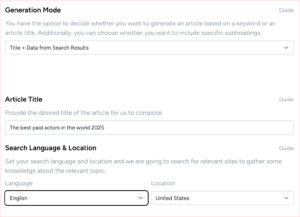You’ve been tasked with developing a content strategy, and the sheer scope of the job feels overwhelming. Where do you even begin?
Setting clear content strategy goals is the cornerstone of any successful marketing plan, yet it’s easy to get lost in the myriad of possibilities. Maybe you’ve found yourself churning out blog posts, social media updates, and newsletters without a clear understanding of their purpose. It’s time to change that.
By establishing well-defined goals, you can:
- Streamline your efforts
- Measure your progress
- Ultimately achieve the results you’re aiming for
This article will guide you through the essential steps needed to set these goals effectively.
By the end, you’ll have a roadmap that not only clarifies your objectives but also aligns your content with the broader aims of your business.
Ready to transform your content strategy from chaotic to coherent? Let’s get started.
Defining clear content strategy goals
Setting clear content strategy goals begins with understanding your target audience and their needs.
To take control of your content’s success, start by defining specific, measurable objectives. This means pinpointing what you want to achieve, such as:
- Increased website traffic
- Higher engagement rates
- Improved conversion rates
Next, dive into keyword research to identify terms and phrases your audience is searching for. By targeting these keywords, you’ll ensure your content aligns with what your audience is looking for, boosting your search engine rankings and visibility.
Don’t forget to establish content performance metrics to track your progress. Metrics like:
- Page views
- Bounce rates
- Social shares
These provide valuable insights into how well your content is performing.
By setting clear content strategy goals, using precise keyword research, and monitoring content performance metrics, you’ll stay in control and steer your strategy towards success. This proactive approach ensures your efforts are focused, measurable, and impactful.
Understanding audience needs and preferences
To craft content that truly resonates, you must delve into your audience’s needs and preferences.
Start by identifying:
- Who they are
- What they value
- How they consume information
This understanding will allow you to align your content strategy goals with their interests.
Use tools like:
- Surveys
- Social media insights
- Analytics
Pay close attention to content performance metrics such as:
- Engagement rates
- Page views
- Time spent on page
These metrics will reveal what’s working and what’s not, helping you fine-tune your approach.
By analyzing these insights, you can tailor your content to address your audience’s pain points and preferences. Additionally, don’t underestimate the power of feedback. Actively seek opinions through:
- Comments
- Reviews
- Direct interactions
While keyword research is crucial, understanding your audience’s needs and preferences lays the foundation for any successful content strategy. When you prioritize their interests, your content becomes more impactful and effective, driving you closer to your content strategy goals.
Conducting thorough keyword research
To elevate your content’s visibility, start by conducting comprehensive keyword research to identify the terms your audience is actively searching for. This process is essential in aligning your content strategy goals with actual user intent, ensuring your efforts are both targeted and effective.
Begin by using keyword research tools like:
- Google Keyword Planner
- SEMrush
These platforms will help you uncover high-volume, low-competition keywords relevant to your niche. Look for terms that resonate with your audience and fit naturally into your content.
Incorporating these keywords strategically can significantly boost your content performance metrics. Aim to integrate them into:
- Headlines
- Subheadings
- Throughout the body of your content
without overstuffing. This balanced approach ensures your content remains engaging and informative while improving its chances of ranking higher in search engine results.
By mastering keyword research, you gain control over your content’s reach and effectiveness, setting a solid foundation for achieving your content strategy goals.
Setting measurable KPIs for success
To gauge the effectiveness of your content strategy, you must establish measurable KPIs that align with your objectives.
Start by identifying KPIs that reflect your content strategy goals.
For instance, if your goal is to increase organic traffic, focus on content performance metrics like:
- Page views
- Organic search rankings
Keyword research plays a crucial role here. By tracking the performance of targeted keywords, you can measure how well your content is resonating with your audience.
KPIs such as:
- Keyword ranking positions
- Click-through rates (CTR)
can provide insights into your content’s effectiveness.
Additionally, consider metrics like:
- Engagement rates
- Social shares
- Conversion rates
These indicators will help you understand how your audience interacts with your content and whether it’s driving desired actions.
By setting precise, measurable KPIs, you gain control over your strategy’s direction and outcomes, making it easier to make data-driven decisions that propel your content strategy goals forward.
Establishing a content calendar
Creating a Content Calendar
Creating a content calendar is essential for maintaining a consistent publishing schedule and ensuring your content aligns with your strategic goals.
By mapping out your content ahead of time, you gain control over what gets published and when, allowing for better alignment with your overall content strategy goals.
Steps to Create a Content Calendar:
-
Conduct Keyword Research:
- Identify topics that resonate with your audience.
- Support your objectives by choosing relevant and engaging topics.
-
Plan Your Content:
- Ensure that the topics are both relevant and engaging.
- Schedule the content to maintain consistency.
Incorporate Content Performance Metrics:
- Tracking these metrics will enable you to adjust your strategy based on what’s working and what’s not.
- For example:
- If a blog post performs well, consider creating similar content.
- If something underperforms, analyze why and refine your approach.
- For example:
Benefits of a Content Calendar:
- Ensures that your team knows what to produce and when.
- Leads to a more streamlined and effective content strategy.
- Provides the control needed to meet your goals.
By establishing a content calendar, you’ll ensure a proactive approach to content creation, ultimately leading to a more efficient and goal-oriented content strategy.
Creating engaging and relevant content
Crafting engaging and relevant content is vital for capturing your audience’s attention and driving meaningful interactions.
To achieve your content strategy goals, focus on understanding your audience’s needs, interests, and pain points.
Start by conducting thorough keyword research to identify topics that resonate with your target demographic. This ensures your content is not only engaging but also discoverable.
When creating content, aim to provide value and solutions.
Use compelling headlines, clear language, and strong visuals to keep readers hooked.
Don’t just inform—engage.
- Ask questions
- Encourage comments
- Foster a sense of community
Tracking content performance metrics is essential for refining your strategy. Regularly review data such as:
- Page views
- Time on page
- Social shares
- Conversion rates
These metrics reveal what’s working and what needs improvement. By continuously optimizing your content based on these insights, you ensure it remains relevant and effective.
Stay proactive, adapt to feedback, and consistently align your efforts with your content strategy goals.
Implementing SEO best practices
To maximize your content’s visibility, it’s crucial to implement SEO best practices effectively.
1. Conduct Thorough Keyword Research
- Understand what your audience is searching for.
- Ensure your content aligns with their needs.
- Boost your search engine rankings.
2. Integrate Keywords Naturally
- Include keywords in titles, headers, and body text.
- Avoid overstuffing to maintain readability.
3. Optimize Meta Descriptions and URLs
- Ensure they are concise and descriptive.
- Include your primary keywords.
4. Enhance Website Performance
- Ensure fast loading speeds.
- Make your site mobile-friendly, as these factors significantly impact your rankings.
5. Utilize Internal Linking
- Helps search engines understand your site’s structure.
- Encourages visitors to explore more content.
- Enhances user experience and boosts content performance metrics.
By implementing these SEO best practices, you’re not just improving your site’s visibility; you’re setting strong content strategy goals that drive consistent traffic and engagement.
Take control and watch your content thrive.
Analyzing content performance metrics
To refine your content strategy, it’s essential to regularly analyze your performance metrics. By doing so, you’ll gain insights into what’s working and what’s not, allowing you to make informed decisions that align with your content strategy goals.
Start by examining key content performance metrics such as:
- Page views
- Bounce rates
- Time on page
- Social shares
These metrics will show you how well your content engages your audience.
Next, dive into keyword research to understand which terms are driving traffic to your site. This helps you identify high-performing keywords and topics, ensuring your content remains relevant and competitive.
- Don’t just focus on the numbers; interpret the data to uncover patterns and trends.
- For instance, if certain types of posts consistently perform well, consider creating more of that content.
Remember, analyzing content performance metrics isn’t a one-time task but an ongoing process that helps you stay agile and effective in achieving your content strategy goals.
Adjusting strategies based on data
Once you’ve gathered and analyzed your data, it’s crucial to adjust your strategies to optimize performance.
Start by revisiting your content strategy goals. Are they still aligned with your findings? If not, refine them. Use insights from your content performance metrics to identify what’s working and what needs improvement. For instance, if certain topics or formats are driving more engagement, focus on these areas.
Next, leverage keyword research to ensure your content remains relevant and discoverable. Update your keywords based on current trends and user behavior. This will help maintain your content’s visibility and attract the right audience.
Don’t hesitate to experiment.
- Test different approaches.
- Measure their impact using your content performance metrics.
- If a strategy isn’t delivering the desired results, pivot quickly.
By making data-driven adjustments, you’ll stay agile and maintain control over your content’s success. Always remember, data is your ally in fine-tuning your strategies for optimal outcomes.
Collaborating with team members
Effective collaboration with team members is essential for executing a successful content strategy.
To achieve your content strategy goals, you need to leverage the strengths and expertise of your team.
Key Steps to Foster Collaboration:
-
Communicate Objectives Clearly:
- Start by clearly communicating your objectives.
- Ensure everyone understands the importance of their roles.
-
Encourage Regular Meetings:
- Discuss keyword research.
- Analyze content performance metrics.
- Keep everyone aligned and focused on the same goals.
-
Empower Team Participation:
- Share insights.
- Suggest improvements.
- Spot trends and identify opportunities.
Use Collaborative Tools:
- Project management software to track progress.
- Maintain transparency.
- Assign specific tasks and hold team members accountable.
Benefits of Collaboration:
By fostering a collaborative environment, you drive your content strategy goals forward and enhance your ability to adapt and respond to dynamic market demands.
Celebrating and learning from successes
Recognizing and analyzing your team’s successes is crucial for maintaining motivation and refining your content strategy.
Celebrate when your content strategy goals are met, as this not only boosts morale but also highlights what’s working.
Take a moment to review the keyword research that contributed to these successes.
- Did certain keywords drive more traffic or engagement?
- Identifying these patterns helps you double down on what works.
Next, dive into your content performance metrics.
- Look at the data to understand which pieces resonated most with your audience.
- Metrics like page views, time spent on page, and social shares can provide valuable insights.
- When you know what content performs best, you can replicate and expand on these successful strategies.
Finally, turn these insights into actionable steps.
- Share the findings with your team to ensure everyone understands what contributed to your success.
- This collaborative reflection not only celebrates achievements but also sets a clearer path for future content strategy goals.
How can I effectively manage and allocate a content marketing budget?
To effectively manage and allocate a content marketing budget, you should start by analyzing your target audience and identifying the platforms where they are most active.
Focus on creating high-quality content that resonates with your audience to maximize engagement and ROI.
Regularly track and measure the performance of your content to make data-driven decisions on where to allocate your budget for the best results.
Be flexible and willing to adjust your strategy based on performance metrics.
What are the best tools for automating content distribution?
To automate content distribution effectively, consider using tools like Buffer, Hootsuite, or Sprout Social.
These platforms offer scheduling, analytics, and automation features to streamline your content sharing process.
By utilizing these tools, you can:
- Save time
- Maintain a consistent posting schedule
- Reach your audience at optimal times
Experiment with different tools to find the one that best fits your needs and allows you to automate your content distribution seamlessly.
How do I handle negative feedback or criticism on my content?
When facing negative feedback or criticism on your content, address it head-on.
Acknowledge the concerns raised and respond constructively. Use it as an opportunity to improve and engage with your audience.
Remember, feedback is a chance to learn and grow. Embrace it as a valuable tool for refining your content strategy and strengthening your connection with your audience.
Keep an open mind and be willing to adapt based on the feedback you receive.
Conclusion
In conclusion, setting clear content strategy goals is essential for success.
By understanding your audience, conducting thorough research, and implementing SEO best practices, you can create engaging content that resonates with your target audience.
By setting measurable KPIs, analyzing performance metrics, and adjusting strategies based on data, you can continuously improve your content strategy.
Collaborating with your team and celebrating successes will keep everyone motivated and focused on achieving your content goals.





